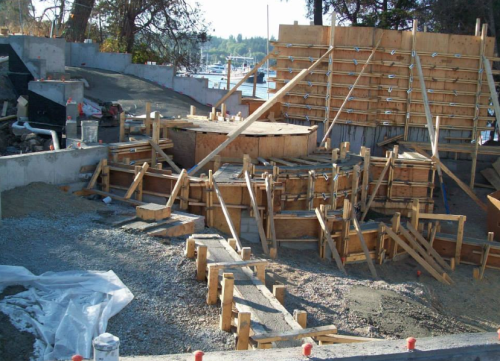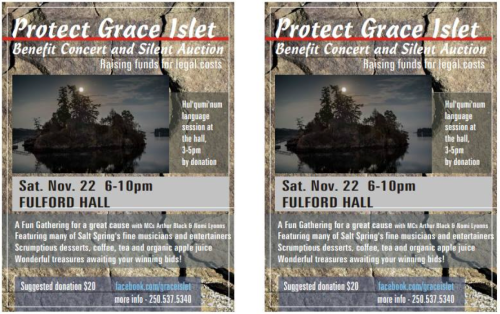
Grace Islet human burial cairn intersected by concrete house foundation. The cairn is said to be under the plywood and concrete square structure. Could there be a more poignant picture of the present day management of archaeological sites in this province? Source: Grace Islet on Facebook, https://www.facebook.com/graceislet
Grace Islet – Shmukw’elu – is a small island (map, pic) in Ganges Harbour, Saltspring Island. It is a Coast Salish cemetery, and it is a settler construction site. How do we reconcile these contradictory uses of this island? I’ve been hesitant to post about this case because I know it’s a long and complicated story of how we got to 2014, when we see burial cairns being literally encased into concrete house foundations. I am quite sure that many people of goodwill made many decisions that seemed right to them at the time. I don’t know what all these decisions are, what happened when, exactly, what the consultant said, how the house owner sleeps at night – I just don’t know all these variables and I am schooled in the idea you should know everything before you say anything. It’s clear though that, somehow, the practice of archaeology in this province led to the Grace Islet outcome. Shouldn’t we try to understand the process? That’s fine in principle, but can be silencing in the face of complexity: as Pierre Bourdieu wrote, “the most successful ideological efforts are those which have no need for words, and then ask no more than complicitous silence.” No more silence, then.

Another view showing the human burial cairn under its rectangular box, bisected by the house foundation. Source: Grace Islet Facebook group, https://www.facebook.com/graceislet
Right now, it literally does not matter to me what the events are that lead to the present, because I like to think any professional archaeologist will agree that the result we see at Grace Islet is not acceptable. It is my professional opinion (yes, I have a day job that lets me say that) that this result does not meet modern standards of heritage conservation. Let us therefore not dissect the process that led us to this place, rather, let us condemn this result.

Largest human burial cairn at Grace Islet is under the octaganal plywood in the centre, and is to be completely surrounded by concrete house foundations. Does this really constitute protection of this feature? Source: Grace Islet Facebook page, https://www.facebook.com/graceislet
I saw some rather good presentations on this topic at the recent BC Archaeology forum, and became aware of the exact solution reached to the competing desires around Grace Islet. Some of the ca. 14 burial cairns on the island were encased in concrete and built into the foundations of the house. To write that this is “disrespectful” is hardly sufficient.

Human burial cairn (covered in green vegetation) with soil stripped away up to its perimeter as part of house development site preparation. Source and description: video of a lecture given by Chris Arnett. https://www.youtube.com/watch?v=zvJcKm0OIDQ
If you’re local, you may have followed this case in the news. You may have read of trespassing, lawsuits, permits, consultants, and blockades. You may have heard the provincial minister defend the outcome, and the landowner protest he followed all the rules. You might have heard of violations of the permit, and their dismissal as immaterial. You may even have heard of Darcy Mathews’ recent dissertation, where he shows the significant spaces of Straits Salish cemeteries transcend the material bounds of the individual cairns. Whatever. Someday it will certainly be worthwhile to try to understand how this happened. Figuring that out is going to be complex and contested. Not my strengths. But consider this: Archaeologists subscribe to an idea called “equifinality”. This is the principle that a single observed outcome could be the result of more than one causal chains, and it might be difficult to separate one of these causes from another. So yes we should try understand the causes. You can hash it out in the comments if you like. But first, we must observe the outcome. And that outcome is shameful.

Signs condemning BC Premier Christy Clark and others at a rally at the BC Legislature. Source: Grace Islet Facebook page, https://www.facebook.com/graceislet
I note there is a fundraiser this weekend, November 22nd, for the legal fees arising from the Grace Islet protection movement. It’s heartening to see a strong arousal of non-Aboriginal concern about respectful treatment of the dead, and interest in the archaeological process in BC. The Grace Islet facebook page is here. There’s an informative hour-long lecture by UBC PhD candidate Chris Arnett available here, which leads you through some of the history of the islet.

November 22nd, Fundraiser for Grace Islet. Click to enlarge, or go here: https://www.facebook.com/events/332687216903424/


Cemetery’s of all kinds are destroyed or physically moved each year because of building or road construction. This cemetery was at least preserved in some way. My question is that if it was a historical cemetery where the dead are known and their living families are known, then there is a clear cut issue of ownership of this property. In most western nations, cemeteries used by a particular family or group indicates ownership. Even if the ownership is of broadly accepted traditional usage, then there is still an ownership issue. This all should have been resolved long ago. If it is a situation where there is no historical or even tradition of use by a particular group, then frankly a thorough excavation should have taken place in order to recover any and all data concerning the past and its prehistoric use. At this point the way it has been handled it is merely a poor attempt that satisfied no one. Land claims by many tribes in Canada and the USA were often ignored in the hope and belief that most tribes would soon be extinct. This in fact seemed to be the fate of many tribes until a number health problems in the 1920’s were resolved. The growth following the defeat of TB’s in the late 50’s and early 60’s brought tremendous growth in the population of most tribes. Still land claim settlements were and continue to be delayed because this belief in extinction is still in play. The archaeology needed to support many traditional claims is often prevented by the mutual distrust of both sides of such issues. The long dead bones of the prehistoric dead often carry the answers that both sides seek. They are indeed sacred but they are also the records of a past where there are no books or documents. If Native Americans choose to bury their past permanently, then so be it, but most folks truly want to understand how our world came to be. Perhaps, an more active role by Native Americans in the research of their prehistory would contribute to a more balance understanding of the archaeology of the Americas. Modern archeological research is certainly flawed by a failure to reach beyond our own cultural understandings.
LikeLike
Thanks for this post Quentin. This saddens me and many of my non-Indigenous neighbors in the Salish Sea as it does defy logic and exalts archaeology as tool for development rather than conservation and knowledge – this appears to be an obvious cemetery in a geographically distinct location and very suitable for protection. Similar to the Poets Cove disaster on Pender Island some years back, a valid opportunity to have a positive outcome has been cast aside for what? IN that case 5000 years of history and many burials were bulldozed so that a resort, that might not last for more a few decades, could stand (albeit relatively briefly) as a testament to our modern wealth and decadence. IN this Grace Islet case, human burials have been incorporated into the foundation of someones home. Wow. This is not precedent setting though as I believe human remains were incorporated into the foundation of a box store recently built in Ganges Harbour. A bit of a trend I guess and in some instances might make sense as opposed to removing the remains moved to a different location. It is very common for ancient human remains and burials to be found in the Salish Sea area, eroding from the shore, on peoples private properties, in parks etc. and First Nations are continuously having to find the time and resources to manage it all. Some folks look toward reburial in a different location but of course that takes land and removes the individual(s) from the location where he/she was INTENDED to be buried, likely with family members in a SACRED spot and so others will bend to the idea of encasing their ancestors in concrete or under someones patio… It is all on a case by case basis and does depend to a certain degree on the amount of respect and acknowledgement afforded to the deceased – and living.
I suppose the recent court loss in Oak Bay has made the permitting body (Arch. Branch) wary of their actions and further lawsuits? BUT given the most recent court ruling on aboriginal rights and title, one might expect quite a bit more from the Province in these matters…
I like this article by B. Penn from late last year in which she suggests that, in similar fashion, someone should be able to apply for a permit to build around the graves in the pioneer cemeteries in Victoria, of course carefully ensuring the remains are encased in concrete to ensure full protection AND proper visitations by relatives, well into the future..
http://focusonline.ca/?q=node/623
LikeLike
To follow up, great piece on the subject of owning sacred (protected?) lands in BC on the National last night, this focusing on Sumas burial ground but touching upon Grace islet:
http://www.cbc.ca/player/News/TV+Shows/The+National/ID/2623092127/
LikeLike
Thank you for posting this Dr.Mackie.
I am new to the field of consulting, and I have always struggled with archaeologists commodification of human remains. I feel the scientific community can be disrespectful of what are the remains of respected ancestors, not fodder for osteological research.
I believe that in the case of Grace Islet, BC heritage legislation has failed Coast Salish peoples. Not that this is an especially controversial viewpoint, but in my opinion the onus is on BC archaeologists to create a general climate of respect for Coast Salish and other First Nation’s burial traditions. This may not seem like much, but I believe that if the boots on the ground are respectful and reticent to excavate human remains it may affect the archaeology branches legislation, At the bare minimum it will foster a respect based relationship between consulting firms and First Nations.
It is great to see the support from the settler community on SSI, but in the background we have the excavation and disrespect of ancestors at construction sights throughout the lower mainland and saanich peninsula (and surely elsewhere across out country).
It takes a lot of courage to stand up to the companies that provide your livelihood, especially when you are a junior archaeologist. Unfortunately I am unsure if I have the courage to do this, and it is likely taking a stand would stop nothing, with the notable exception of my career.
LikeLike
Nice post 🙂
LikeLike
I personally find it difficult to comprehend how any responsible 21st century government agency could justify this outcome; especially in Canada, a country that prides itself on cultural understanding. Having said this (and please understand that the above is my personal perspective on the matter), there are other precedents to consider (I offer this solely to add to the discussion, and not an attempt to defend the outcome in this case). For example, the excavation of a large native Hawaiian cemetery in Maui county in the late 1980s resulted in the site being “capped” by construction of an overlying golf course. The matter of importance to the native population, as I understand it at least, was that their ancestors remains be permitted to remain in the ground and be protected from (further) disturbance. The golf course would ensure that this happened. Now, one can easily argue that a golf course is certainly more aesthetically pleasing than a concrete foundation for a home, but anthropologists recognize that such aesthetic choices are culturally biased. One can also easily point out that the current case does not involve native Hawaiians, and so the comparison is not valid; if so, that too may be a fair argument. But we might also consider that we have long recognized that the Earth’s dead vastly outnumber the Earth’s living, and that the intrusion of the living onto the resting places of the dead is in fact an increasingly common occurrence. Well known historic cemeteries in many parts of the world have been reclaimed and repurposed, so one cannot claim that First Nation remains are necessarily singled out in this regard (though it would be difficult to deny that there has been a history of differential treatment in the past). Does any of this justify the outcome in the currect case? Certainly not, in my personal opinion, but I do recognize that there are other precedents, and other opinions; all of which make this a difficult situation.
LikeLike
Pingback: Around the Archaeology Blog-o-sphere Digest #10 | Doug's Archaeology
Thank god, it appears that this outrageous activity has finally come to a conclusion with the prov govt purchasing Grace Islet. Someone should remind those construction workers that it might be a good idea to undergo a cleansing by local First Nation spiritual workers.
LikeLike
Pingback: Threats to Bears Ears and other Indigenous sacred sites are a violation of human rights | Development Channel
Pingback: Threats to Bears Ears and other Indigenous sacred sites are a violation of human rights | Revolutionary Minds
Pingback: Is Trump's threat to sacred Bears Ears like Taliban blowing up Buddhas?